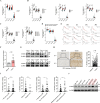SUMO2 inhibits ACSL3 protein degradation to antagonize erastin-induced ferroptosis in hepatocellular carcinoma
- PMID: 40526170
- PMCID: PMC12174167
- DOI: 10.1007/s12672-025-02921-5
SUMO2 inhibits ACSL3 protein degradation to antagonize erastin-induced ferroptosis in hepatocellular carcinoma
Abstract
Hepatocellular carcinoma (HCC) is the prevalent form of primary liver cancer with a high rate of morbidity and death. Ferroptosis is a kind of regulatory cell death mode that depends on iron. Small ubiquitin-like modifier 2 (SUMO2) is linked to HCC progression; however, its role in ferroptosis within HCC remains unclear. Our goal was to evaluate the regulatory effects and molecular mechanisms of SUMO2 in HCC ferroptosis. SUMO2 was screened by bioinformatics analysis, and its expression was verified in HCC tissues. Stable SUMO2 knockdown and overexpression cell lines were created. The downstream target protein acyl-CoA synthetase long-chain family member 3 (ACSL3) of SUMO2 was screened to assessed the mechanism of SUMO2 regulating ferroptosis in HCC cells. In HCC tissues, SUMO2 expression was higher and linked to a worse prognosis for patients. SUMO2 overexpression reduced malondialdehyde content, prevented mitochondrial crest loss, and increased glutathione level under ferroptotic stimuli. Meanwhile, overexpression of SUMO2 lowered the expression of molecules that promote ferroptosis and raised the expression of molecules that prevent it. SUMO2 knockdown produced the opposite effects. Mechanistically, SUMO2 elevated ACSL3 protein level by inhibiting its entry into the ubiquitin-proteasome degradation pathway and enhanced its protein stability. The inhibitory effects of SUMO2 on ferroptosis in HCC cells were reversed by ACSL3 knockdown in SUMO2-overexpressing cells. In summary, SUMO2 binds to ACSL3, preventing its protein degradation, thereby increasing its protein stability and level, which in turn negatively regulates ferroptosis in HCC cells. These results point to interesting targets and therapeutic approaches for HCC.
Keywords: Erastin; ACSL3; Ferroptosis; Hepatocellular carcinoma; Protein degradation; SUMO2.
© 2025. The Author(s).
Conflict of interest statement
Declarations. Ethics approval and consent to participate: The present study was approved by the Ethics Committee of The Second Affiliated Hospital of Chongqing Medical University (No. 2021 − 242) and written informed consent was provided by all patients prior to the study start. All procedures were performed in accordance with the ethical standards of the Institutional Review Board and The Declaration of Helsinki, and its later amendments or comparable ethical standards. Original blot images: The reason for “physical cropping” of the membrane before primary antibody incubation is that it can improve detection sensitivity, save antibodies and reagents, achieve multi-target detection, avoid signal cross-contamination, and adapt to different experimental needs. Competing interests: The authors declare no competing interests.
Figures





Similar articles
-
Mitochondrial alanyl-tRNA synthetase 2 mediates histone lactylation to promote ferroptosis in intestinal ischemia-reperfusion injury.World J Gastrointest Surg. 2025 Jun 27;17(6):106777. doi: 10.4240/wjgs.v17.i6.106777. World J Gastrointest Surg. 2025. PMID: 40584474 Free PMC article.
-
Matrix stiffness-dependent PD-L2 deficiency improves SMYD3/xCT-mediated ferroptosis and the efficacy of anti-PD-1 in HCC.J Adv Res. 2025 Jul;73:265-282. doi: 10.1016/j.jare.2024.08.021. Epub 2024 Aug 17. J Adv Res. 2025. PMID: 39159723 Free PMC article.
-
E3 ubiquitin ligase CHIP interacts with transferrin receptor 1 for degradation and promotes cell proliferation through inhibiting ferroptosis in hepatocellular carcinoma.Cell Signal. 2024 Jun;118:111148. doi: 10.1016/j.cellsig.2024.111148. Epub 2024 Mar 21. Cell Signal. 2024. PMID: 38521179
-
The Ac/N-Degron Domain of MARCHF6 E3 Ubiquitin Ligase and Its Role in Regulating Ferroptosis.Cells. 2025 Jun 22;14(13):954. doi: 10.3390/cells14130954. Cells. 2025. PMID: 40643475 Free PMC article. Review.
-
Vitamin D: Production, Metabolism, and Mechanism of Action.2025 Jun 15. In: Feingold KR, Ahmed SF, Anawalt B, Blackman MR, Boyce A, Chrousos G, Corpas E, de Herder WW, Dhatariya K, Dungan K, Hofland J, Kalra S, Kaltsas G, Kapoor N, Koch C, Kopp P, Korbonits M, Kovacs CS, Kuohung W, Laferrère B, Levy M, McGee EA, McLachlan R, Muzumdar R, Purnell J, Rey R, Sahay R, Shah AS, Singer F, Sperling MA, Stratakis CA, Trence DL, Wilson DP, editors. Endotext [Internet]. South Dartmouth (MA): MDText.com, Inc.; 2000–. 2025 Jun 15. In: Feingold KR, Ahmed SF, Anawalt B, Blackman MR, Boyce A, Chrousos G, Corpas E, de Herder WW, Dhatariya K, Dungan K, Hofland J, Kalra S, Kaltsas G, Kapoor N, Koch C, Kopp P, Korbonits M, Kovacs CS, Kuohung W, Laferrère B, Levy M, McGee EA, McLachlan R, Muzumdar R, Purnell J, Rey R, Sahay R, Shah AS, Singer F, Sperling MA, Stratakis CA, Trence DL, Wilson DP, editors. Endotext [Internet]. South Dartmouth (MA): MDText.com, Inc.; 2000–. PMID: 25905172 Free Books & Documents. Review.
References
-
- Sung H, Ferlay J, Siegel RL, Laversanne M, Soerjomataram I, Jemal A, et al. Global cancer statistics 2020: GLOBOCAN estimates of incidence and mortality worldwide for 36 cancers in 185 countries. CA Cancer J Clin. 2021;71(3):209–49. - PubMed
-
- Llovet JM, Zucman-Rossi J, Pikarsky E, Sangro B, Schwartz M, Sherman M, et al. Hepatocellular carcinoma. Nat Rev Dis Primers. 2016;2:16018. - PubMed
-
- Sangiovanni A, Prati GM, Fasani P, Ronchi G, Romeo R, Manini M, et al. The natural history of compensated cirrhosis due to hepatitis C virus: a 17-year cohort study of 214 patients. Hepatology. 2006;43(6):1303–10. - PubMed
-
- Ioannou GN, Splan MF, Weiss NS, McDonald GB, Beretta L, Lee SP. Incidence and predictors of hepatocellular carcinoma in patients with cirrhosis. Clin Gastroenterol Hepatol. 2007;5(8):938–e454. - PubMed
Grants and funding
- cstc2021jcyj-msxmX0018/General Project of Chongqing Natural Science Foundation
- 2021XM3027/Special Support for Chongqing Postdoctoral Research Project
- kryc-yq-2224/Kuanren Talents Program of the Second Affiliated Hospital of Chongqing Medical University
- 82103206/National Natural Science Foundation of China
LinkOut - more resources
Full Text Sources
Miscellaneous
